-
Welcome back Guest! Did you know you can mentor other members here at H-M? If not, please check out our Relaunch of Hobby Machinist Mentoring Program!
You are using an out of date browser. It may not display this or other websites correctly.
You should upgrade or use an alternative browser.
You should upgrade or use an alternative browser.
Just some minor surface rust...
- Thread starter francist
- Start date
- Joined
- Feb 14, 2016
- Messages
- 623
When you get it back together paint it up with some pin stripe and flames .
- Joined
- Feb 2, 2013
- Messages
- 3,962
looking good Frank! there are still parts floating around on ebay
good luck in the restoration!!!
good luck in the restoration!!!
- Joined
- Sep 5, 2013
- Messages
- 3,793
A bit more progress on the little Craftsman over the past few weeks. It's starting to look more like a lathe again.
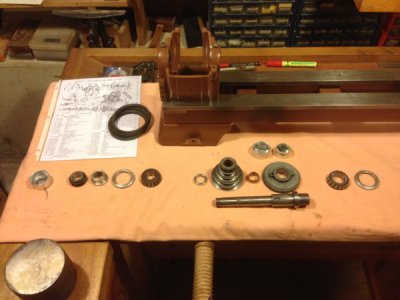
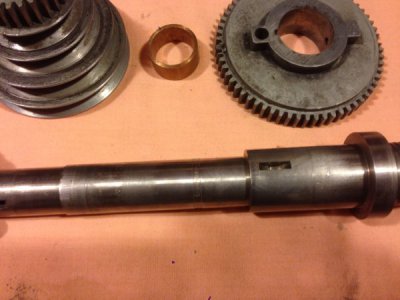
The spindle was in great shape although I do think someone had had it apart once before. One dust cover was missing but that's it, everything else was there and not looking worn at all. Fortunately I had a spare cover from my miller so I used that. And I did NOT commit the cardinal sin of failing to have the belt in place before putting the spindle through which would have meant tearing it apart again. I left the bull gear pin out instead, so yes, I still had to tear it apart again!
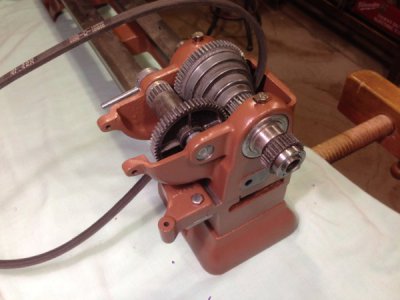
So far I've not had to replace many parts, and the ones that I have were pretty minor. I built new spacer washers for the back gear assembly, a new back gear lever, and made a new indexing pin to engage the index holes on the bull gear. Oddly some of those are kind of goofed up, almost like a previous owner had used them for locking the spindle when changing chucks. Not serious, just unnecessary.
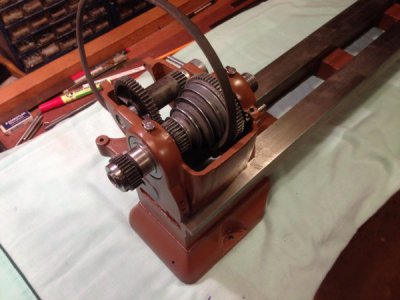
Don't know where I'll head next -- carriage and lead screw I guess. The tumbler reverse probably wouldn't take a lot either, so maybe play with that first.
Thanks for looking.
-frank


The spindle was in great shape although I do think someone had had it apart once before. One dust cover was missing but that's it, everything else was there and not looking worn at all. Fortunately I had a spare cover from my miller so I used that. And I did NOT commit the cardinal sin of failing to have the belt in place before putting the spindle through which would have meant tearing it apart again. I left the bull gear pin out instead, so yes, I still had to tear it apart again!

So far I've not had to replace many parts, and the ones that I have were pretty minor. I built new spacer washers for the back gear assembly, a new back gear lever, and made a new indexing pin to engage the index holes on the bull gear. Oddly some of those are kind of goofed up, almost like a previous owner had used them for locking the spindle when changing chucks. Not serious, just unnecessary.

Don't know where I'll head next -- carriage and lead screw I guess. The tumbler reverse probably wouldn't take a lot either, so maybe play with that first.
Thanks for looking.
-frank
F
Firestopper
Forum Guest
Register Today
Frank, thats looking great man, ^^what mikey said^^
- Joined
- Nov 29, 2017
- Messages
- 553
This is the procedure I've used in the past ......used washing soda instead of lye (Arm & Hammer from the grocery store) ....works great.If all of the parts can be removed then tank it.
Get a plastic trash can and a can of drain cleaner (lye) along with a battery charger and some rebar.
Locate a roof rafter or other hard point above and place the lathe bed on a rope and suspend it lengthwise in the trash can.
Place the rebar along the sides inside and hold in place with spring clamps or whatever is handy.
Battery charger positive goes on the rebar and negative on the rusty part and wire wheel a spot to make good connection.
Connect rebar parts all together.
Fill with water about 1/2 way then pour in about 1/3 can of lye then fill to where rusty part covered with a couple inches.water.
Turn charger on and note the current meter.
Should see bubbles from rusty part.
The rebar will collect nasty crud which we call "corn dogs" and amp meter will drop.
Carefully without bumping pull them out and smack them inside your trash can to clean them off.
The above will get the rust and anything organic from the bed.
Do not place anything not iron or steel in it.
With all the rust go now evaluate condition..
If the ways look good and not trashed it could be fixed.
Assemble before much work and try it out.
<REDACTED> but they are still handy for lots of tasks due to small size more than enough lathe for certain things so it can be fixed up and used as a "do-fer" do for now...You can learn things while hunting for next one as we all do...we started with one of those and always made money on them.
Sent from my SAMSUNG-SGH-I337Z using Tapatalk
Nice work on the restoration!!
- Joined
- Dec 9, 2016
- Messages
- 1,133
If I didnt see a project like this take place first hand I would Never believe that this is the same lathe that was in the fire! Its amazing what a small bit of science a splash of ingenuity and some good old fashioned elbow grease can accomplish! Cant wait to see your finished product, Nice work.
- Joined
- Sep 5, 2013
- Messages
- 3,793
Some more progress on the lathe resurrection. I'm starting to run into parts that are too burned up or otherwise damaged to be reused, so it's not going quite as speedily as before.
The gears cleaned up alright for the most part, but the knob for the tumbler reverse was no longer present so I needed to come up with one of those. At the outset of this little adventure I decided that I wasn't going to sweat over doing a full-on "restoration" to use the popular term, so I didn't need the knob to be a match to anything. I have a few handles that I save from discarded diamond wheel dressers, and this seemed a perfect opportunity to make use of one. They're already knurled, a nice diameter, away we go. I was going to reuse the pin, but the more I looked at it the more I figured my chances of hitting that off-centre hole in the 3/16" diameter shaft was pretty slim. Easier to just turn a new one from some drill rod and pin the new handle to it instead.
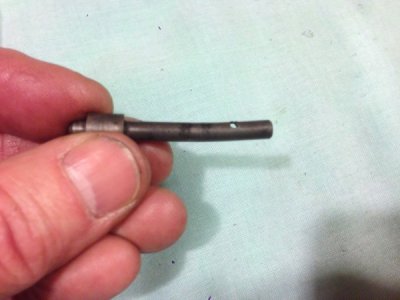
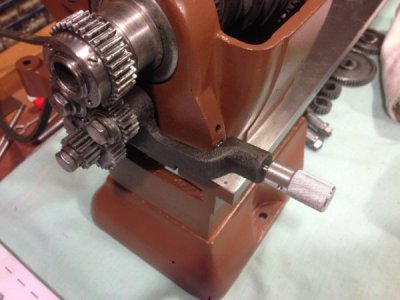
On to the lead screw. I still had the one front bearing that supports the screw as well as the change gear banjo, but not the one from the tailstock end. I remember being quite stumped when I was first disassembling the machine as to why there was only one bearing on the lead screw. Like, how does that happen, who runs a lathe with just a bearing at one end? Then I twigged. The Zamak bearing was indeed still there, just slightly "modified". The heat came from the right front, and at just over 750 F the bearing melted off the two mounting screws and dribbled down to come to rest on top of the bolt holding the foot to the bench. That's the little silver-coloured half moon shaped thing in the photo below. Cool, eh?
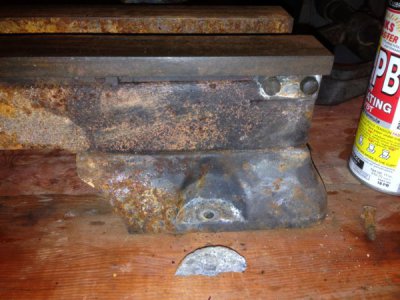
Anyway, I needed a new bearing so better just make one. Roughed out most of it on the shaper, then finished up on the belt sander. It took more time to set up for drilling the hole, which I subsequently sleeved with nylon 6/6, than anything else really. And I seriously underestimated the degree to which I would need to measure the thing so the lead screw would run true.
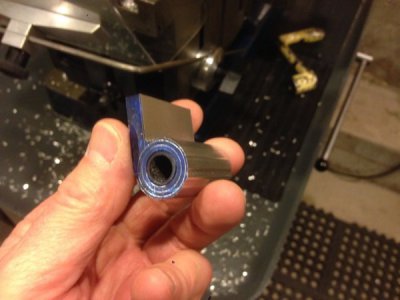
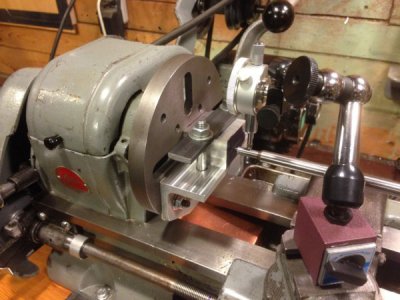
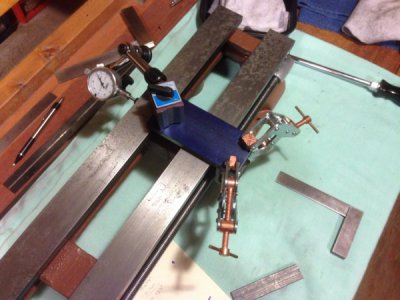
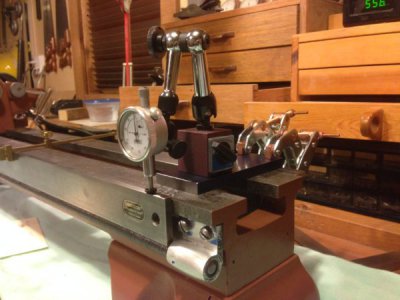
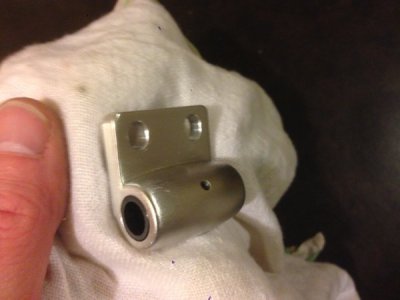
In the end though, or on the end as it were, I think it turned out ok. I stayed with the classic barrel shape although mine is just a hair on the chunky side. The screw turns freely, that's the important part.
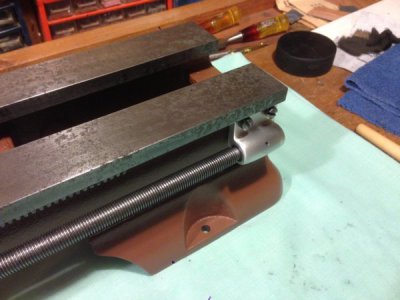
Thanks for looking!
-frank
The gears cleaned up alright for the most part, but the knob for the tumbler reverse was no longer present so I needed to come up with one of those. At the outset of this little adventure I decided that I wasn't going to sweat over doing a full-on "restoration" to use the popular term, so I didn't need the knob to be a match to anything. I have a few handles that I save from discarded diamond wheel dressers, and this seemed a perfect opportunity to make use of one. They're already knurled, a nice diameter, away we go. I was going to reuse the pin, but the more I looked at it the more I figured my chances of hitting that off-centre hole in the 3/16" diameter shaft was pretty slim. Easier to just turn a new one from some drill rod and pin the new handle to it instead.


On to the lead screw. I still had the one front bearing that supports the screw as well as the change gear banjo, but not the one from the tailstock end. I remember being quite stumped when I was first disassembling the machine as to why there was only one bearing on the lead screw. Like, how does that happen, who runs a lathe with just a bearing at one end? Then I twigged. The Zamak bearing was indeed still there, just slightly "modified". The heat came from the right front, and at just over 750 F the bearing melted off the two mounting screws and dribbled down to come to rest on top of the bolt holding the foot to the bench. That's the little silver-coloured half moon shaped thing in the photo below. Cool, eh?

Anyway, I needed a new bearing so better just make one. Roughed out most of it on the shaper, then finished up on the belt sander. It took more time to set up for drilling the hole, which I subsequently sleeved with nylon 6/6, than anything else really. And I seriously underestimated the degree to which I would need to measure the thing so the lead screw would run true.





In the end though, or on the end as it were, I think it turned out ok. I stayed with the classic barrel shape although mine is just a hair on the chunky side. The screw turns freely, that's the important part.

Thanks for looking!
-frank
Last edited:
